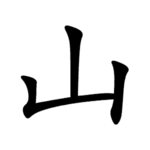Radical 46
Radical 46 or radical mountain (山部) meaning "mountain" is one of the 31 Kangxi radicals (214 radicals total) composed of three strokes. It is found in the names of mountains generally in east Asia.
| 山 | ||
|---|---|---|
| ||
| 山 (U+5C71) "mountain" | ||
| Pronunciations | ||
| Pinyin: | shān | |
| Bopomofo: | ㄕㄢ | |
| Gwoyeu Romatzyh: | shan | |
| Wade–Giles: | shan1 | |
| Cantonese Yale: | sāan | |
| Jyutping: | saan1 | |
| Pe̍h-ōe-jī: | san | |
| Japanese Kana: | サン san (on'yomi) やま yama (kun'yomi) | |
| Sino-Korean: | 산 san | |
| Names | ||
| Chinese name(s): | (Left) 山字旁 shānzìpáng (Top) 山字頭/山字头 shānzìtóu (Bottom) 山字底 shānzìdǐ | |
| Japanese name(s): | 山/やま yama (Left) 山偏/やまへん yamahen (Top) 山冠/やまかんむり yamakanmuri | |
| Hangul: | 메 me | |
| Stroke order animation | ||
 | ||
In the Kangxi Dictionary, there are 636 characters (out of 49,030) to be found under this radical.
山 is also the 39th indexing component in the Table of Indexing Chinese Character Components predominantly adopted by Simplified Chinese dictionaries published in mainland China.
In Taoist cosmology, 山 (mountain) is the nature component of the bagua diagram 艮 gèn. This diagram corresponds to the I Ching trigram ☶.
Evolution
 Oracle bone script character
Oracle bone script character Bronze script character
Bronze script character Large seal script character
Large seal script character Small seal script character
Small seal script character
Derived characters
| Strokes | Character |
|---|---|
| +0 | 山 |
| +1 | 乢 屲 |
| +2 | 屳 屹 |
| +3 | 屺 屻 屼 屽 屾 屿SC (=嶼) 岀 岁SC (=歲 -> 止) 岂SC (=豈 -> 豆) 岃 |
| +4 | 岄 岅 岆 岇 岈 岉 岊 岋 岌 岍 岎 岏 岐 岑 岒 岓 岔 岕 岖SC (=嶇) 岗SC (=崗) 岘SC (=峴) 岙 (=嶴) 岚SC (=嵐) 岛SC (=島) 岜 |
| +5 | 岝 岞 岟 岠 岡 岢 岣 岤 岥 岦 岧 岨 岩 岪 岫 岬 岭 岮 岯 岰 岱 岲 岳 岴 岵 岶 岷 岸 岹 岺 岻 岼 岽SC (=崬) 岾 岿SC (=巋) 峀 峁 峂 峃SC (=嶨) 峄SC (=嶧) 峅 (JP) |
| +6 | 峆 峇 峈 峉 峊 峋 峌 峍 峎 峏 峐 峑 峒 峓 峔 峕 峖 峗 峘 峙 峚 峛 峜 峝 (=峒) 峞 峟 峠 (JP) 峡SC/JP (=峽) 峢 峣SC (=嶢) 峤SC (=嶠) 峥SC (=崢) 峦SC (=巒) 峧 |
| +7 | 峨 峩 (=峨) 峪 峫 峬 峭 峮 峯HK variant (=峰) 峰 峱 峲 峳 峴 峵 島 峷 峸 峹 峺 峻 峼 峽 峾 峿 崀 崁 崂SC (=嶗) 崃 崄SC (=嶮) 崅 |
| +8 | 崆 崇 崈 崉 崊 崋 崌 崍 崎 崏 崐 (=崑) 崑 崒 崓 崔 崕 崖 崗 崘 (=崙) 崙 崚 崛 崜 崝 崞 崟 崠 崡 崢 崣 崤 崥 崦 崧 崨 崩 崪 崫 崬 崭SC (=嶄) 崮 崯 |
| +9 | 崱 崲 |
| +10 | 嵟 嵠 嵡 嵢 嵣 嵤 嵥 嵦 嵧 嵨 嵩 嵪 嵫 嵬 嵭 嵮 嵯 嵰 嵱 嵲 嵳 嵴 嵵 嵶 |
| +11 | 嵷 嵸 嵹 嵺 嵻 嵼 嵽 嵾 嵿 嶀 嶁 嶂 嶃 嶄 嶅 嶆 嶇 嶈 嶉 嶊 嶌 (=島) 嶋 (=島) 嶍 嶎 |
| +12 | 嶏 嶐 嶑 嶒 嶓 嶔 嶕 嶖 嶗 嶘 嶙 嶚 嶛 嶜 嶝 嶞 嶟 嶠 嶡 嶢 嶣 嶤 嶥 |
| +13 | 嶦 嶧 嶨 嶩 嶪 嶫 嶬 嶭 嶮 嶯 嶰 嶱 嶲 嶳 嶴 嶵 嶶 |
| +14 | 嶷 嶸 嶹 (=島) 嶺 嶻 嶼 嶽 嶾 嶿 |
| +16 | 巀 巁 巂 巃 巄 巅SC (=巔) |
| +17 | 巆 巇 巈 巉 巊 巋 巌JP (=巖) |
| +18 | 巍 巎 巏 巐 |
| +19 | 巑 巒 巓 巔 巕 |
| +20 | 巖 巗 (=巖) 巘 巙 巚 (=巘) |
Literature
- Fazzioli, Edoardo (1987). Chinese calligraphy : from pictograph to ideogram : the history of 214 essential Chinese/Japanese characters. calligraphy by Rebecca Hon Ko. New York, 1987: Abbeville Press. ISBN 0-89659-774-1.CS1 maint: location (link)
- Lunde, Ken (Jan 5, 2009). "Appendix J: Japanese Character Sets" (PDF). CJKV Information Processing: Chinese, Japanese, Korean & Vietnamese Computing (Second ed.). Sebastopol, Calif.: O'Reilly Media. ISBN 978-0-596-51447-1.
This article is issued from Wikipedia. The text is licensed under Creative Commons - Attribution - Sharealike. Additional terms may apply for the media files.
